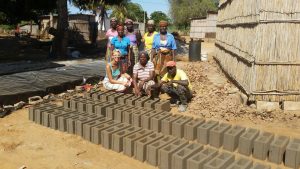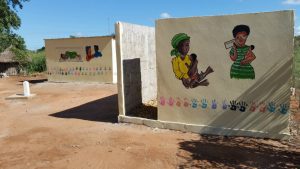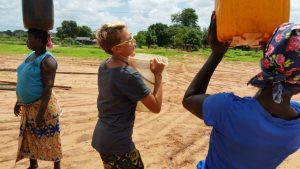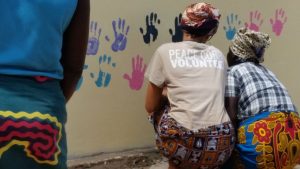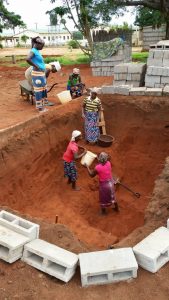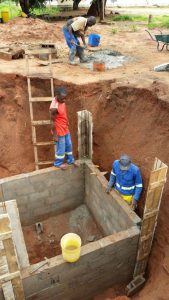This project in Mozambique has been completed under the direction of Peace Corps Volunteer Leah Kirby. The project was designed to construct a facility in the market. However, difficulties arose, and the project was changed, demonstrating the flexibility and focus of the participants.
The final design resulted in the construction of a latrine and a bathroom/shower at the local health center. 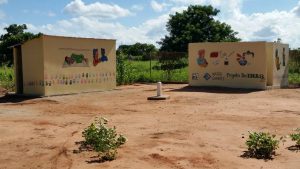
To read about the beginning of the project, CLICK HERE.
Following is a summary of Leah’s conclusion report:
Scope of Project:
Mangungumete is a small community without electricity or running water in northern Inhambane province of Mozambique. As a health Peace Corp Volunteer I work a lot with the community and health center doing preventative talks, workshops and weekly youth group classes, but still saw the need to take more action. Together with local leaders and respected community members, we decided the greatest need was for a public latrine/bathroom.But development is not about giving things that are needed to people who need them, but rather teaching and helping the people help themselves so in the future they won’t need such assistance. It’s all about sustainability and creating a better future once you’re gone. So instead of simply doing a basic water-related hygiene and sanitation project, we made it into an organizational strengthening and empowerment project!
We selected a 83% female work crew to plan, organize, design, and construct the latrines and bathrooms. Together we fought gender norms by mixing cement, making blocks, digging the sewage tank, building the walls, and painting the murals! This ended up being way more than a construction project, it was development on all fronts! Mangungumete will never be the same.
Project Progression:
Planning: While it may have taken 6 months for the local leaders to accept the idea of the project), afterwards, we made progress. 4 months later we had moved the location of the local beer sales, which was necessary for both the safety and security of the market, but also to guarantee the construction of this project would be unaffected by the consumers of this brew. During this time we were also working on the budget, which was difficult, since most of the supplies must be bought out of town, due to the fact that very little is sold here in Mangungumete. Also, finding a plumber in a village where there are only 6 manual water pumps and 8 wells is an impossible feat of its own.Implementation: In October, we quickly gathered a group of women to make the blocks, dig the sewage tank, etc. from a larger group of local volunteers who do cleanup of the town, called “Projecto de Inas”. We had decided to have these workers make the blocks and construct the latrine because this gives them more ownership over the project and teaches them a new skill set that they can feel proud about and possibly gives them a job opportunity in the future.
By November, I had bought the cement, sand and other materials needed and together the 20 of us learned how to make cinder blocks! They were a little hesitant at first, thinking that this is ‘men’s work’ and that they wouldn’t succeed, but by their third day, they were rocking it! I never saw smiles so big or songs sung so proudly as they were mixing away. And when people walked by our site, I would hear my women call out to those who made fun of them, saying “Atintumbe tinga maha!”, which roughly translates to “Yes, we women can!”
But as most projects go, we hit the ground running, only to run straight into a road block. I had returned to the district capital to confirm that we were going to start digging the sewage tank in the market. But since approving and now, November, they had received funds to build their own latrine in the market, making the current market project unnecessary.
We then took a week off from labor to regroup the local leaders and respected members of the community, including 3 women, to figure out what to do. Finally, we decided to simply move the project to the hospital, since they also have no facilities and have a large population, serving over 20 communities. However, the hospital’s water pump was stolen 2 months prior, resulting in us doing a construction project without a water source nearby.
Regardless, by November 25, we had broken ground and started digging the 4 meter by 2 meter sewage tank. Three weeks later, we had reached a depth of 4 meters, and started to put in the foundation. However, we were set back again. The rains had finally come and caved in our hole, not only making us re-dig, but also buy more supplies, because the force had destroyed the rebar and blocks already set in place. While we waited for the sand to dry, allowing us to uncover the destruction, we started the bathroom/shower room. Depending on the weather we went back and forth between the latrine and bathroom construction for 2-3 weeks.
By the end of December, we had put the lids on the latrine and almost finished the bathroom. Now we were in the clear, when the rains came again in full force for a straight week, they only delayed construction, not also set us back. We kept going and quickly completed the bathroom, plastered the outer walls and begun to paint it while others finished the latrine walls and put a roof on it. On Jan 28th, we had finished construction and I invited all those who helped with the planning and implantation of this project to come put their handprints of the final project!
The women were so proud and couldn’t wait to later tell their friends and family that that hand was theirs. Now no one could say that women cannot do ‘men’s work’ because here is the proof, and no one could dismiss her handprint.
Final Result:
Latrine: The building is 4 meters by 2 meters, and divided in half, creating 2 latrine rooms. This is sitting on top of a 4 meter deep sewage tank. There are lids for both holes to limit the amount of flies and smell. There are cement windows and the doorways are open to allow constant air flow. There is a metal roof, which will prevent rain from entering and filling up the tank. The outer walls are plastered and painted with health-themed murals showing the importance of using mosquito nets and condoms, along with the hand prints of the people who helped complete this project.Bathroom/Shower: This building is 4 meters by 2 meters, and divided in half, creating 2 shower rooms. There are benches for people to sit and put a bucket of water. One floor is cement and the other was left with gravel as a compromise since there was debate over which type of floor was better and preferred by the public. Again, the outer walls were plastered and painted with health-themed murals showing the importance of breast feeding, vaccination, family planning, hand washing and going to the hospital, along with the hand prints of the people who helped complete this project.
Running Water: Tubes were also run to bring running water closer to the latrines and bathrooms. This faucet will encourage use of the facilities as well as hand washing afterwards.
Community: The high level of community involvement in this project truly helped fortify the strength and respect that these women get in Mangungumete. They gained organizational strengthening, new skill sets, but most importantly, empowerment and pride. For me, this is the best outcome of this project, and as a side bonus the patients that use the Mangungumete Health Center now have clean facilities to use, which will lessen illnesses related to poor hygiene. A health talk about microbes, transmission of diseases and treatment of diarrhea illnesses was given during the grand opening of the project.
We are grateful to Leah for her leadership in directing this important and inspirational project to completion. We again extend our thanks to the Robert Victor Sager and Beatrice Mintz Sager Foundation for providing the funding.
